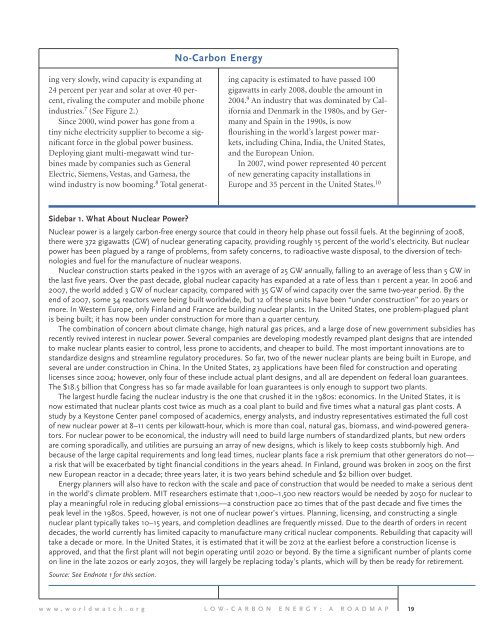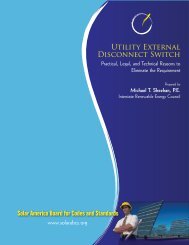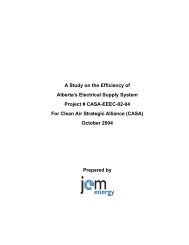Worldwatch Institute
Worldwatch Institute
Worldwatch Institute
Create successful ePaper yourself
Turn your PDF publications into a flip-book with our unique Google optimized e-Paper software.
No-Carbon Energy<br />
ing very slowly, wind capacity is expanding at<br />
24 percent per year and solar at over 40 percent,<br />
rivaling the computer and mobile phone<br />
industries. 7 (See Figure 2.)<br />
Since 2000, wind power has gone from a<br />
tiny niche electricity supplier to become a significant<br />
force in the global power business.<br />
Deploying giant multi-megawatt wind turbines<br />
made by companies such as General<br />
Electric, Siemens, Vestas, and Gamesa, the<br />
wind industry is now booming. 8 Total generating<br />
capacity is estimated to have passed 100<br />
gigawatts in early 2008, double the amount in<br />
2004. 9 An industry that was dominated by California<br />
and Denmark in the 1980s, and by Germany<br />
and Spain in the 1990s, is now<br />
flourishing in the world’s largest power markets,<br />
including China, India, the United States,<br />
and the European Union.<br />
In 2007, wind power represented 40 percent<br />
of new generating capacity installations in<br />
Europe and 35 percent in the United States. 10<br />
Sidebar 1. What About Nuclear Power<br />
Nuclear power is a largely carbon-free energy source that could in theory help phase out fossil fuels. At the beginning of 2008,<br />
there were 372 gigawatts (GW) of nuclear generating capacity, providing roughly 15 percent of the world’s electricity. But nuclear<br />
power has been plagued by a range of problems, from safety concerns, to radioactive waste disposal, to the diversion of technologies<br />
and fuel for the manufacture of nuclear weapons.<br />
Nuclear construction starts peaked in the 1970s with an average of 25 GW annually, falling to an average of less than 5 GW in<br />
the last five years. Over the past decade, global nuclear capacity has expanded at a rate of less than 1 percent a year. In 2006 and<br />
2007, the world added 3 GW of nuclear capacity, compared with 35 GW of wind capacity over the same two-year period. By the<br />
end of 2007, some 34 reactors were being built worldwide, but 12 of these units have been “under construction” for 20 years or<br />
more. In Western Europe, only Finland and France are building nuclear plants. In the United States, one problem-plagued plant<br />
is being built; it has now been under construction for more than a quarter century.<br />
The combination of concern about climate change, high natural gas prices, and a large dose of new government subsidies has<br />
recently revived interest in nuclear power. Several companies are developing modestly revamped plant designs that are intended<br />
to make nuclear plants easier to control, less prone to accidents, and cheaper to build. The most important innovations are to<br />
standardize designs and streamline regulatory procedures. So far, two of the newer nuclear plants are being built in Europe, and<br />
several are under construction in China. In the United States, 23 applications have been filed for construction and operating<br />
licenses since 2004; however, only four of these include actual plant designs, and all are dependent on federal loan guarantees.<br />
The $18.5 billion that Congress has so far made available for loan guarantees is only enough to support two plants.<br />
The largest hurdle facing the nuclear industry is the one that crushed it in the 1980s: economics. In the United States, it is<br />
now estimated that nuclear plants cost twice as much as a coal plant to build and five times what a natural gas plant costs. A<br />
study by a Keystone Center panel composed of academics, energy analysts, and industry representatives estimated the full cost<br />
of new nuclear power at 8–11 cents per kilowatt-hour, which is more than coal, natural gas, biomass, and wind-powered generators.<br />
For nuclear power to be economical, the industry will need to build large numbers of standardized plants, but new orders<br />
are coming sporadically, and utilities are pursuing an array of new designs, which is likely to keep costs stubbornly high. And<br />
because of the large capital requirements and long lead times, nuclear plants face a risk premium that other generators do not—<br />
a risk that will be exacerbated by tight financial conditions in the years ahead. In Finland, ground was broken in 2005 on the first<br />
new European reactor in a decade; three years later, it is two years behind schedule and $2 billion over budget.<br />
Energy planners will also have to reckon with the scale and pace of construction that would be needed to make a serious dent<br />
in the world’s climate problem. MIT researchers estimate that 1,000–1,500 new reactors would be needed by 2050 for nuclear to<br />
play a meaningful role in reducing global emissions—a construction pace 20 times that of the past decade and five times the<br />
peak level in the 1980s. Speed, however, is not one of nuclear power’s virtues. Planning, licensing, and constructing a single<br />
nuclear plant typically takes 10–15 years, and completion deadlines are frequently missed. Due to the dearth of orders in recent<br />
decades, the world currently has limited capacity to manufacture many critical nuclear components. Rebuilding that capacity will<br />
take a decade or more. In the United States, it is estimated that it will be 2012 at the earliest before a construction license is<br />
approved, and that the first plant will not begin operating until 2020 or beyond. By the time a significant number of plants come<br />
on line in the late 2020s or early 2030s, they will largely be replacing today’s plants, which will by then be ready for retirement.<br />
Source: See Endnote 1 for this section.<br />
w w w . w o r l d w a t c h . o r g L O W - C A R B O N E N E R G Y : A R O A D M A P 19









